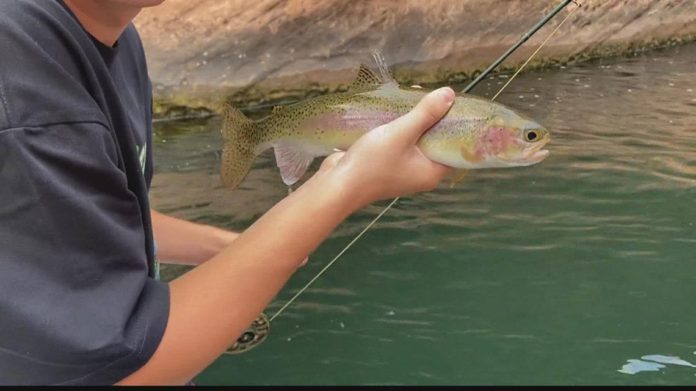The river’s water temperature is warming up to levels that are threatening the livelihood of a prized fish and a valuable tourism industry.
ARIZONA, USA — The drying out of the desert southwest is causing ripple effects everywhere, including the Colorado River. The river’s water temperature is warming up to levels that are threatening the livelihood of prized fish and a valuable tourism industry.
Rainbow trout fishing is a national draw
Fishing guide Dave Trimble has been taking anglers on the upper Colorado River for more than two decades.
“It’s our office and our home and the place we spend time with people we care about and love to fish with,” Trimble said.
Fly fishing for rainbow trout attracts tourists from across the country and sustains a small group of fishing guides like Trimble.
But conditions are changing on the river threatening the trout’s existence.
“It’s definitely one of the best fisheries in Arizona and to see it potentially vanish is heartbreaking, to say the least,” Trimble said.
The temperature is rising
Although the rainbow trout fishing is still good, Trimble knows his days as a trout fly fishing guide may be numbered. The threat lies upriver at Lake Powell.
Historically low water levels mean the water gushing through the dam is getting warmer every week. Temperatures are normally in the high 40’s and low 50’s. Last week the water temperature hit 64 degrees.
“Sixty-four is toasty,” said Scott Rogers, Manager of the Arizona Game and Fish Department’s Aquatic Wildlife northern Arizona region.
At 68 degrees and higher, trout become lethargic and are vulnerable to dying. Larger trout are especially vulnerable.
Temperatures are predicted to reach as high as 69 or 70 degrees at Lees Ferry this month, Rogers said.
“It is a problem. We’ve been aware of it for quite a while. And we’re working with other agencies to do whatever we can to try to mitigate what appears to be coming,” Rogers said.
Why cold temperature matters
Rainbow trout have an optimum metabolic temperature rate of 68 degrees. But that’s based on an optimum food base. The fish in the Colorado River typically eat midges and black flies, which are small particles of food. Stress can start occurring within Rainbow Trout at 68 or 69 degrees, which means the fish are “metabolically charged up” and can get tired very quickly.
The USGS is conducting bug surveys to determine how warmer waters are impacting the food supply of fish.
Other impacts of warmer river water
The trout is not a keystone species. Its collapse would not likely have a cascading effect on other systems.
However, warmer waters also allow nonnative bass and catfish to thrive. They could potentially eat other fish and threaten native species.
“It’s hard to put that genie back in the bottle,” Rogers said.
Prior to the completion of the Glen Canyon Dam in the early 60s, the water that flowed through the Grand Canyon got as warm as 85 degrees in the summer. Rainbow Trout were introduced into the Colorado River after the dam was built because the water was so predictably cold year-round.
The good and bad of warmer water
Like other wildlife destinations in the southwest, the aridification of the region that federal scientists say is being made worse by climate change is altering what we’ve taken for granted for so long. The threat of trout losing their dominance at Lees Ferry would be another consequence.
“That is a critical and one of the most important fisheries we have in the state and that would be a huge loss,” Rogers said.
When the increase of temperatures reached as high as 59 degrees, there was a likely increase of humpback chub and other native fish populations in the Grand Canyon, according to the Department of Interior.
However the continued rise in temperature increase the risk of cool/warm-water nonnative fish like brown trout, green sunfish, smallmouth bass and walleye “which could have a devastating impact on the humpback chub population in Grand Canyon,” according to the Department of the Interior.
Up to Speed
Catch up on the latest news and stories on the 12 News YouTube channel. Subscribe today.
Credit: Source link






























